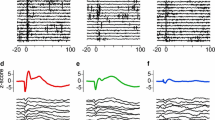Summary
-
1.
The catfishKryptopterus was stimulated with a.c.fields of various strengths and frequencies.
-
2.
The responses of the afferent nerve fiber of the ampullary electroreceptors to these fields and the response of central units in the cerebellum to the same fields were measured and compared.
-
3.
The primary afferent fibers are spontaneously active (50 to 90 imp./sec) and display greatest frequency modulation in response to imposed fields with frequencies of 3 to 5 Hz (Fig. 2).
-
4.
The electroresponsive units in the cerebellum were classified into three main types according to their different spontaneous activities and their sensitivity maxima, which occur in different stimulus-frequency ranges.
-
5.
Typea cerebellar units (13 neurons) have a low and irregular spontaneous activity (0.1 to 10 imp./sec) and, at 1 to 10 Hz stimulation, they are 10 to 30 times more sensitive to imposed fields than single primary fibers (Figs. 3, 4). The impulse frequency maximum lies at stimuli of 5 Hz (Fig. 7), but the largest numbers of impulses per period occur at 0.3 Hz or at lower frequencies (Figs. 3, 5).
-
6.
Typeb units (4 neurons) have no spontaneous activity and are most sensitive to frequencies below 1 Hz; the longer the stimulus period, the more impulses per period occur (Figs. 4, 6) and the higher their frequency (Fig. 7).
-
7.
The typec unit (one neuron) has a regular spontaneous activity which is best modulated with stimuli of 10 to 20 Hz (Fig. 8).
Similar content being viewed by others
References
Andrianov, G. N., Ilyinsky, O. B.: Some functional properties of central neurons connected with the lateral-line organs of the catfish (Ictalurus nebulosus). J. comp. Physiol.86, 365–376 (1973)
Bennett, M. V. L.: Mechanisms of electroreception. In: Lateral line detectors (P. Cahn, ed.). Bloomington: Indiana Univ. Press 1967
Bennett, M. V. L.: Electroreception. In: Fish physiology, vol. V, Sensory systems and electric organs. New York-London: Academic Press 1971a
Bennett, M. V. L.: Synaptic transmission from receptor cells of an acustico-lateralis receptor. Biophysical Society Abstract, 15th Annual Meeting 132a, 1971b
Bullock, T. H.: General Introduction. An essay on the discovery of sensory receptors and the assignment of their functions together with an introduction to electroreceptors. Handbook of sensory physiology, vol. III 3, p. 1–12 (A. Fessard, ed.). Berlin-Heidelberg-New York: Springer 1974
Dijkgraaf, S.: Electroreception in the catfishAmiurus nebulosus. Experientia (Basel)24, 187–188 (1968)
Dijkgraaf, S., Kalmijn, A. J.: Versuche zur biologischen Bedeutung der Lorenzinischen Ampullen bei den Elasmobranchiern. Z. vergl. Physiol.53, 187–194 (1966)
Jørgensen, J. M., Flock, Å., Wersäll, J.: The Lorenzinian ampullae ofPolyodon spathula. Z. Zellforsch.130, 362–377 (1972)
Kalmijn, A. J.: The detection of electric fields from inanimate and animate sources other than electric organs. Handbook of sensory physiology, vol. III 3, p. 147–200 (A. Fessard, ed.). Berlin-Heidelberg-New York: Springer 1974
Knudsen, E. J.: Behavioral thresholds to electric signals in high frequency electric fish. J. comp. Physiol.91, 333–353 (1974)
Lissmann, H. W., Machin, K. E.: Electric receptors in a non-electric fish (Clarias). Nature (Lond.)199, 88–89 (1963)
Mullinger, A. M.: The fine structure of ampullary electric receptors inAmiurus. Proc. roy. Soc. B160, 345–359 (1964)
Peters, R. C., Buwalda, R. J. A.: Frequency response of the electroreceptors (“small pit organs”) of the catfish,Ictalurus nebulosus LeS. J. comp. Physiol.79, 29–38 (1972)
Peters, R. C., Bretschneider, F.: Electric phenomena in the habitat of the catfishIctalurus nebulosus LeS. J. comp. Physiol.81, 345–362 (1972)
Peters, R. C., Wijland, F. van: Electro-orientation in the passive electric catfishIctalurus nebulosus LeS. J. comp. Physiol.92, 273–280 (1974)
Roth, A.: Propriétés fonctionelles et morphologiques des différents organes de la ligne latérale des Mormyridés. J. Physiol. (Paris)59, 486 (1967)
Roth, A.: Electroreceptors in the catfishAmiurus nebulosus. Z. vergl.Physiol.61, 196–202 (1968)
Roth, A.: Elektrische Sinnesorgane beim ZwergwelsIctalurus nebulosus (Amiurus nebulosus). Z. vergl. Physiol.65, 368–388 (1969)
Roth, A.: Zur Funktionsweise der Elektrorezeptoren in der Haut von Welsen (Ictalurus): Der Einfluß der Ionen im Süßwasser. Z. vergl. Physiol.75, 303–322 (1971)
Roth, A.: Wozu dienen die Elektrorezeptoren der Welse? J. comp. Physiol.79, 113–135 (1972)
Roth, A.: Electroreceptors in Brachiopterygii and Dipnoi. Naturwissenschaften60, 106 (1973a)
Roth, A.: Ampullary electroreceptors in catfish: afferent fiber activity before and after removal of the sensory cells. J. comp. Physiol.87, 259–275 (1973b)
Suga, N.: Electrosensitivity of specialized and ordinary lateral line organs of the electric fish,Gymnotus carapo. In: Lateral line detectors (P. Cahn, ed.). Bloomington: Indiana Univ. Press 1967
Szabo, T.: Sense organs of the lateral-line system in some electric fish of the Gymnotidae, Mormyridae and Gymnarchidae. J. Morph.117, 229–249 (1965)
Wachtel, A. W., Szamier, R. B.: Special cutaneous receptor organs of fish. IV. Ampullary organs of the nonelectric catfish,Kryptopterus. J. Morph.128, 291–308 (1969)
Author information
Authors and Affiliations
Additional information
Supported by the Deutsche Forschungsgemeinschaft.
Rights and permissions
About this article
Cite this article
Roth, A. Central neurons involved in the electroreception of the catfishKryptopterus . J. Comp. Physiol. 100, 135–146 (1975). https://doi.org/10.1007/BF00613965
Received:
Issue Date:
DOI: https://doi.org/10.1007/BF00613965




